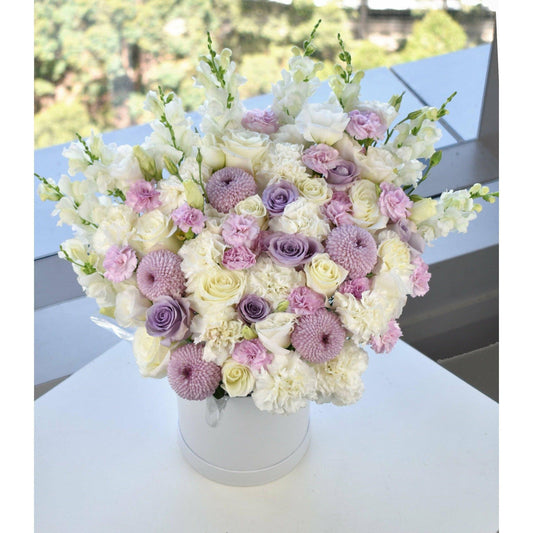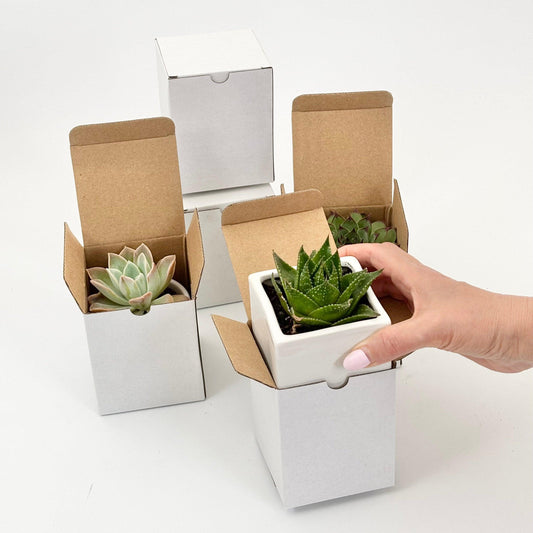How to Take Care of Succulents in Winter and Summer?
Succulents are beloved for their hardiness and low-maintenance nature, but they still require special care during the extreme seasons of winter and summer. Understanding how to adjust your succulent care routine can ensure that your plants thrive year-round. Pay attention to your plants, and they will reward you with their resilience and charm.

Winter Care for Succulents
Light and Temperature
During the winter, it's important to provide succulents with as much light as possible. Place them in south-facing windows to ensure they receive ample sunlight. If natural light is not enough, use grow lights to supplement. The best temperature range for succulents in winter is between (10°C to 15°C). Ensure that they are shielded from drafts and kept away from cold windowsills to avoid frost damage.
Watering
Succulents go into a dormant phase during winter, which means they need much less water. Overwatering during this time can cause root rot. Only water your succulents when the soil is completely dry, which could be as infrequent as once every 3-4 weeks. Make sure the pot has good drainage to prevent waterlogging.
Humidity
Succulents thrive in low humidity. Winter heating can dry the air, benefiting succulents. For humid homes, use a dehumidifier or place succulents in a lower humidity room.
Fertilizing
Do not fertilize succulents during winter as they do not need extra nutrients while dormant. Resume fertilization in spring when the growth cycle starts again.
Summer Care for Succulents
Light and Temperature
During the summer, succulents thrive in lots of sunlight. However, excessive direct sunlight, especially during the hottest part of the day, can lead to sunburn. It's important to gradually expose your succulents to more light and provide shade during peak hours if needed. The best temperatures for succulents in the summer range from 21°C to 29°C.
Watering
In summer, succulents need more frequent watering compared to winter. Make sure to water them thoroughly so that the water reaches the roots. Let the soil dry out completely between waterings to avoid root rot. Generally, watering once a week is enough, but this may change depending on the climate and the specific needs of the plants.
Humidity
In hot and dry summer conditions, succulents can benefit from occasional misting to increase humidity. However, be cautious not to overdo it, as consistently high humidity can lead to fungal issues.
Fertilizing
Summer is the growing season for most succulents, so light fertilization can promote healthy growth. Use a balanced, water-soluble fertilizer diluted to half strength, and apply it once a month.
General Succulent Care Tips
Soil and Potting
Succulents thrive in well-draining soil. A cactus or succulent mix is ideal, as it prevents water from sitting in the soil. Ensure pots have drainage holes to allow excess water to escape, reducing the risk of root rot.
Pest Control
Succulents are susceptible to pests like mealybugs and aphids, especially in the summer. Regularly inspect your plants and promptly treat infestations with insecticidal soap or neem oil.
Pruning and Propagation
Remove any dead or damaged leaves to maintain the plant's health and appearance. Succulents can be easily propagated from leaves or cuttings, which makes it simple to expand your collection or share with friends.
Send Gift Plants Australia wide
-
Personalised Succulent in White Ceramic Pots
Regular price From $14.00Regular price -
Branded Succulent in Ceramic Cube Pot with Gift Box
Regular price From $16.00Regular price -
Succulents in handbags gift box
Regular price From $11.00Regular price -
Succulent in Colourful Ceramic Pots
Regular price $13.00Regular price -
Succulent in Pink pot
Regular price $13.00Regular price -
Succulent in Green Pot
Regular price $13.00Regular price -
Succulent in a Diamond Pattern Pot
Regular price $13.00Regular price -
Succulent in Concrete Cylinder Pot
Regular price $13.00Regular price -
Succulent in White Pots
Regular price $13.00Regular price -
Succulent in Grey Pots
Regular price $13.00Regular price -
Succulent in Black Pots
Regular price $13.00Regular price
Sydney Flower Delivery
-

Flower Boxes
At OfficeFlower every flower arrangement is thoughtfully designed by expert florists and...
-

Dried Flower Arrangements
Smart, Professional Dried and Preserved Flower Arrangements Delivered To Your Home Or...
-

Rose Boxes
Our rose boxes feature stunning and carefully arranged rose flowers that captivate...
-
 Sale
SalePremium Rose Box
Regular price From $95.00Regular price$110.00Sale price From $95.00Sale -
Love Box - Pink and Red Roses
Regular price From $95.00Regular price$110.00Sale price From $95.00Sale -
Black Box of Premium Red Roses
Regular price From $110.00Regular price$159.00Sale price From $110.00Sale -
Half Dozen Boxed Roses
Regular price $85.00Regular price -
Premium White Rose Box
Regular price From $110.00Regular price -
Love Box - Yellow Roses
Regular price From $99.00Regular price$110.00Sale price From $99.00Sale -
Yellow Rose Box
Regular price From $155.00Regular price
-
Bright Beauty | White, Purple, and Pink Blooms
Regular price From $95.00Regular price$139.00Sale price From $95.00Sale -
Pretty Pink
Regular price $139.00Regular price -
Red and Pink Blooms
Regular price From $139.00Regular price -
Black Box of Bright Beauty | White, Purple, and Pink Blooms
Regular price From $139.00Regular price -
 Sale
SaleThe Secret Garden
Regular price $130.00Regular price$149.00Sale price $130.00Sale -
Purple and White Blooms
Regular price From $89.00Regular price$129.00Sale price From $89.00Sale -
White and Red Blooms
Regular price From $149.00Regular price -
 Sale
SalePretty Purple
Regular price From $125.00Regular price$139.00Sale price From $125.00Sale































